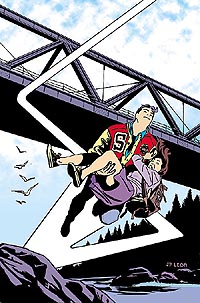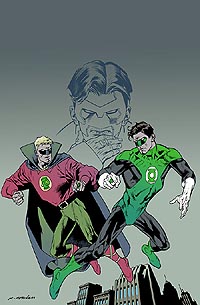|
Each week we take a critical look at some of the best books on the stands, courtesy of Big Guy's Comics (the unofficial comic book store of FanboyPlanet.com). If you publish a book that you want us to be covering, contact us. Or contact Derek. He doesn't have enough to do.
Hey Kids! Comics!
Action Comics #791
The Invitation
writer: Benjamin Raab, artist: Derec AucoinAnd the slow merging of the comics and the television show begins anew. It's slight and subtle, and Raab does a good job of not forcing the issue. Now Clark is a former Smallville Crow, and invitation to emcee this year's homecoming dance.
The prospect fills him with unease, which he doesn't share with Lois. So desperate for a distraction from the idea is he, that he spends time playing chess with Plastic Man at the JLA Watchtower (nice touch). This worries Plastic Man so much he calls Lois (collect).
Once in Kansas (note to Gough and Millar: Smallville is in a whole different state than Metropolis), the story comes out. It's a tale of tragedy and missed opportunity. Without beating us over the head with its obviousness, it marks a small step from Clark Kent, callow youth, to Clark Kent the man.
Inking himself, Aucoin delivers journeyman work. His Lois looks strangely like Kristin Kreuk, but that's probably all in part of the nod to the television series. More impressively, Aucoin has a good mastery of facial expressions that his simple line-work doesn't reveal at first glance. Oddly, though, everybody seems vaguely double-chinned.
Topped by a nostalgic cover by J.P. Leon, this issue of Action Comics marks one of the most satisfying Superman reads in a while.
Rating:

Birds Of Prey #43
Blind Spot
writer: Chuck Dixon, artists: Dave Ross and Andrew PepoyAfter being integral to the overall cross-over, with this issue Birds Of Prey falls into the pattern of the rest of the bat-books: offer a couple of pages in which characters rehash everything we know, then advance the mystery by inches over one or two more pages. Devote the rest of the book to the regular goings-on of the main cast.
Does anybody remember Sasha? Just checking.
It's a disappointment, because the crossover has given this book deserved attention. If it's going to be a chapter in Bruce Wayne: Fugitive, let it really be one. Not that Bruce is a fugitive; we all know where he is.
The main story brings Deathstroke to Gotham City, clearly about to be set against Black Canary. Both of them will be racing to find a miracle genetic cure that could, of course, change the course of mankind. One small obstacle stands in their way; the cure is on Dinosaur Island, home of The War That Time Forgot.
With only a few issues left, Dixon clearly wants to go out having fun, which this promises to be. But it also promised to be part of a different story. All we get is promises, and that's just frustrating.
At least Ross and Pepoy continue the solid art that characterizes the book.
Rating:

DC 1st: Green Lantern
Tomorrow's Hero
writer: Benjamin Raab, artists: Pete Woods, Jamal Igle, Rick Burchett and Andy OwensThanks to Hypertime, fans can easily swallow retroactive continuity. Retroactive characterization is another matter. Because the whole Parallax thing has not gone down easily when blamed on "Hal was always really, really cocky and arrogant, and he was an alkie, and…and…and he called his best friend Pieface, for gosh sakes," the Powers That Be at DC have been flailing around for other explanations.
Over in the pages of the Deadman mini-series, they blamed Neron for it. (And that's why Guy Gardner can go to hell for being a drinker, but Hal Jordan can be redeemed for being a mass murderer - the devil made him do it.) But clearly, that isn't enough, either. So with this "DC First" we get a re-telling of the first team-up between Alan Scott and Hal Jordan, which Raab makes interesting.
As is often the problem with these re-castings of classic stories, it takes a while for the reader to understand who knew who when and how. Too much bizarre revamping of the characters has occurred between now and then. (If I never hear another reference to the Starheart, I can be happy.) So while Alan and Hal know each other, they hadn't really "teamed up" until this story. To make matters more confusing, it's all a flashback being relayed to Kyle, whose own continuity right now is still a little in flux.
All of it seems little more than an excuse to throw blame on Krona for Hal's corruption, which doesn't necessarily make it better. What does work is cool artwork, especially from (I think) the Woods and Burchett team, making some segments look as if they were done by Joe Staton and Ric Estrada, a classic team of the '70's responsible for most of the adventures of both Hal and Alan in their heyday.
But with Staton at least still working, why not just have them do it?
Rating:

JSA #36
Time-Bound
writers: David Goyer and Geoff Johns, artists: Leonard Kirk and Keith ChampagneJohns and Goyer have used the last few issues to revive some of DC's most potentially powerful heroes, with mixed results. Fighting in a world controlled by the Ultra-Humanite, the best of the heroes' personalities come to the fore, but the urge to define them occasionally trips up the writers.
Jakeem Thunder continues to develop into far more than Grant Morrison created him to be. Blessedly free of blacked out dialogue, his young mind already grasps the power he can wield better than Johnny Thunder ever did. And yet he has a respect for the original man with the thunderbolt, a respect that could prove everyone's undoing.
Finally Hector Hall breaks out of his self-pity, effectively teaming with Wildcat against (essentially) his own parents. There's heavy-handed symbolism there, folks, but it works, while Rick Tyler reveals the peace he's reached with his own father. There's a poignance to his situation that Johns and Goyer will obviously be playing on from time to time. They may be treading on the maudlin, but wisely pull back.
Where things get awkward is with Captain Marvel. Jakeem comments, "he's been called simple. An anachronism." And truly, fans have grumbled the same. But as Jakeem's commentary continues, it just doesn't really flow. Yes, Captain Marvel is in many ways simple. But in desperate times, isn't that a comfort?
Johns and Goyer try to give Marvel a depth that may be there, but it's awkwardly phrased, distracting from some powerful layouts by Kirk and Champagne. They leave the last page without words; the effect might even have worked starting a couple of pages earlier.
It's a minor gripe, based on a great personal affection for Marvel that the writers obviously share. For me, just seeing Captain Marvel save the day is enough. I don't have to know why.
Rating:

Origin #6
Dust To Dust
writer: Paul Jenkins, artists: Andy Kubert and Richard IsanoveJemas and Quesada must be so grateful to Frank Miller. With all the hoopla over DK2 being chronically late and not living up to expectations, Origin has kind of slipped by unnoticed. True, it's not as late and maybe not as bad as fans claim Miller's work to be, but it still sucks as a story.
I can't blame them for this. Alex Ross established the pattern with his Earth X series of maxi-series and specials; he taught Marvel that we would buy empty, slow-moving stories if they told us that at least they looked good.
And Origin does look good. Page after page, Isanove has turned Kubert's already sterling pencils into something sumptuous. As an art book alone, that hardback edition may be worth it. But for this final issue, the artwork looks a little rushed, not quite as careful as earlier issues.
Then again, everything about this "final" issue feels rushed. Rose seeks to escape to a new life, Dog comes seeking revenge, and Logan seeks…well, we really don't know. But at least his basic nobility asserts itself.
In an obvious nod, the bulk of this climax takes place where the movie introduced Logan: at a bar, in a cage match. It serves to literally wrap up this chapter of Logan's mysterious life, but there's still way too much unanswered.
Dog may be Sabertooth. Then again, so might Smitty be. And the mystery surrounding Logan's parentage still stands. At least until Origin III. Sorry to jump the gun, but I'm betting that Origin II will only continue teasing us.
Rating:

For alternate views and other books, check out Daryl Tay's site, Unique Frequencies.

All comics were reviewed by Derek McCaw unless otherwise noted.

















